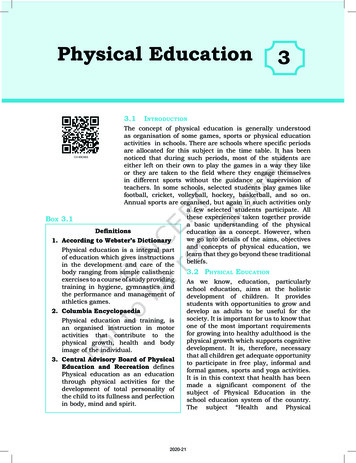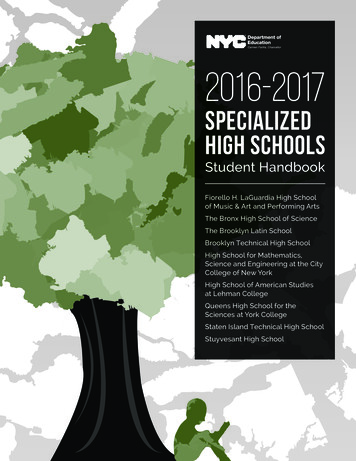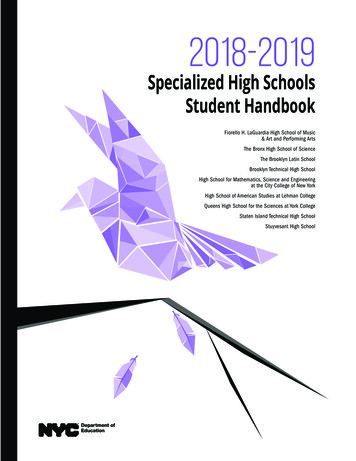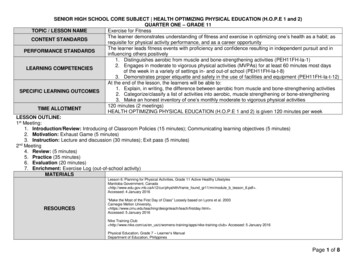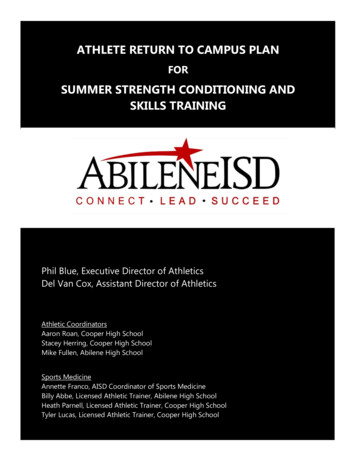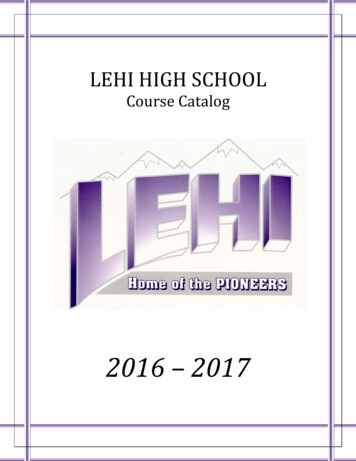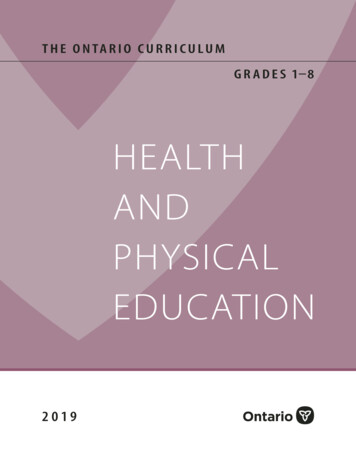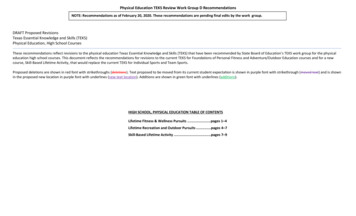
Transcription
Physical Education TEKS Review Work Group D RecommendationsNOTE: Recommendations as of February 20, 2020. These recommendations are pending final edits by the work group.DRAFT Proposed RevisionsTexas Essential Knowledge and Skills (TEKS)Physical Education, High School CoursesThese recommendations reflect revisions to the physical education Texas Essential Knowledge and Skills (TEKS) that have been recommended by State Board of Education’s TEKS work group for the physicaleducation high school courses. This document reflects the recommendations for revisions to the current TEKS for Foundations of Personal Fitness and Adventure/Outdoor Education courses and for a newcourse, Skill-Based Lifetime Activity, that would replace the current TEKS for Individual Sports and Team Sports.Proposed deletions are shown in red font with strikethroughs (deletions). Text proposed to be moved from its current student expectation is shown in purple font with strikethrough (moved text) and is shownin the proposed new location in purple font with underlines (new text location). Additions are shown in green font with underlines (additions).HIGH SCHOOL, PHYSICAL EDUCATION TABLE OF CONTENTSLifetime Fitness & Wellness Pursuits . pages 1–4Lifetime Recreation and Outdoor Pursuits . pages 4–7Skill-Based Lifetime Activity .pages 7–9
§116.52. Lifetime Fitness & Wellness Pursuits Foundations of Personal Fitness (One-HalfCredit).(a)General requirements. This course is a one semester course that can act as a stand-alonecourse or as a prerequisite course for innovative courses, such as PE3. This course mayfulfill one half credit for the physical education or elective requirements for graduationupon successful completion. This course is the recommended prerequisite for all otherphysical education courses.(b)Introduction.(c)(1)In Physical Education, students acquire the knowledge and skills for movementthat provide the foundation for enjoyment, continued social developmentthrough physical activity, and access to a physically-active lifestyle. The studentexhibits a physically-active lifestyle and understands the relationship betweenphysical activity and health throughout the lifespan.(2)Physical Education: Lifetime Fitness and Wellness Pursuits course offersexposure to relevant approaches for the foundation of healthy living, personalfitness, physical literacy and lifetime wellness strategies. Students in PhysicalEducation: Lifetime Fitness and Wellness Pursuits will acquire the knowledgeand skills to show an assessed level of learning for application of these conceptsto continue beyond High School. Students will exhibit an understanding ofdifferentiated programs, including components for personal fitness development,lifetime health strategies and overall wellness competencies.(2)Foundations of Personal Fitness represents a new approach in physicaleducation and the concept of personal fitness. The basic purpose of this course isto motivate students to strive for lifetime personal fitness with an emphasis onthe health-related components of physical fitness. The knowledge and skillstaught in this course include teaching students about the process of becoming fitas well as achieving some degree of fitness within the class. The concept ofwellness, or striving to reach optimal levels of health, is the corner stone of thiscourse and is exemplified by one of the course objectives-students designingtheir own personal fitness program.Knowledge and skills.(1)(2)Movement Patterns/Movement Skills. While participating in physical activity,the student applies physiological and biomechanical principles to improve healthrelated fitness. The student is expected to:(A)apply physiological and fitness principles related to exercise andtraining such as warm- up/cool down, overload, frequency,intensity, specificity, or progression; and(B)apply biomechanical principles related to exercise and trainingsuch as force, leverage, and type of contraction.Performance Strategies Social development. During physical activity, thestudent applies strategies and safety practices associated with physical activityChanges made by Work Group D are indicated in italics.Physical Education, High School1February 2020
develops positive self- management and social skills needed to workindependently and with others. The student is expected to:(3)(A)apply rules, and procedures to ensure safety, andetiquette; and(B)recognize and resolve conflicts during physical activity.(B)describe appropriate practices and procedures to improveskill and strategy in various fitness activities.(C)consistently perform skills, and strategies, and rules at abasic level of competency(D)use internal and external information to modifymovement during performance using internal andexternal feedbackHealth and physical activities/fitness Physical activity and health. The studentapplies fitness principles that encompass personal fitness programs, nutrition,technology and environmental awareness safety practices associated with physicalactivity. The student is expected to:(A)demonstrate safety procedures such as including wearing properattire, using and equipment safely, and recognizing situationalenvironmental hazards awareness spotting during gymnasticsand using non-skid footwear;(B)describe examples and exercises that may be harmful or unsafe;(B)participate in a variety of activities that develop health-relatedphysical fitness activities such as aerobic exercise to developcardiovascular efficiency;(C)explain the relationship between physical fitness and wellnesshealth;(D)demonstrate measure and evaluate personal the skill-relatedcomponents of physical fitness such as agility, balance,coordination, power, reaction time, and speed;(E)design and implement a personal fitness program that includesaspects of cardiorespiratoryvascular endurance, muscularstrength/endurance, and flexibility components;(F)exhibit a level of competency in two or more aerobic and two ormore anaerobic activities non-aerobic activities such asmuscular strength and endurance activities;(G)identify correctly the critical elements for successfulperformance within the context of the activity;(H)analyze measure and evaluate personal fitness status in terms ofcardiorespiratory vascular endurance, muscular strength andendurance, flexibility and body composition;Changes made by Work Group D are indicated in italics.Physical Education, High School2February 2020
(I)select and use appropriate technology tools to evaluate, monitor,and improve physical development;(J)describe training principles appropriate for enhancing toenhance cardiorespiratory endurance, muscular strength andendurance, and flexibility.(K)assessment of resting heart rate and active heart rate;(L) (C) explain the relationships between fluid balance hydration,physical activity, and environmental conditions. such as loss ofwater and salt during exercise; and(4)(4)(D)identify the effects of substance abuse on physical performance.(M)identify and describe examples and exercises techniques thatmay be harmful or unsafe.Physical activity and health. The student applies fitness principles during apersonal fitness program. The student is expected to:(A)explain the relationship between physical fitness and health;(B)participate in a variety of activities that develop health-relatedphysical fitness activities such as aerobic exercise to developcardiovascular efficiency;(C)demonstrate the skill-related components of physical fitnesssuch as agility, balance, coordination, power, reaction time, andspeed;(D)compare and contrast health-related and skill-related fitness;(E)describe methods of evaluating health-related fitness such as Coopers 1.5mile run test;(F)list and describe the components of exercise prescription such as overloadprinciple, type, progression, or specificity;(G)design and implement a personal fitness program; and(H)evaluate consumer issues related to physical fitness such as marketingclaims promoting fitness products and services.Social and Emotional Health. During physical activity, the student developspositive self-management and social skills needed to work independently andwith others. The student is expected to:(A)investigate positive and negative attitudes towards exercise and physicalactivities;(B)describe and analyze the relationship between physical activity and socialemotional health concepts.(C)recognize and resolve conflicts during physical activity;Changes made by Work Group D are indicated in italics.Physical Education, High School3February 2020
(5)(D)recognize and respond to challenges, successes, conflicts, and failures inphysical activities in socially appropriate ways; and(E)accept successes and performance limitations of self and others, byexhibiting appropriate behavior and responses, and(E)recognize that improvement is possible with appropriate practice.Lifetime Wellness Physical activity and health. The student comprehendspractices that will impact daily performance, physical activity, and healththroughout the lifespan. The student is expected to:(A)investigate positive and negative attitudes towards exercise and physicalactivities;(B)describe physical fitness activities that can be used for stress reduction;(A) (C) explain how the risks of overtraining may contribute to risk factors suchas inactivity, negative health choices, eating disorders, and substanceabuse problems such as bulimia and anorexia;(B) (D) analyze explain the relationship between sound nutritional practices andphysical activity;(C) (E) identify explain myths associated with physical activity and nutritionalpractices as a consumer;(D) (F) analyze how nutrition, and exercise, and other factors impacts bodycomposition methods of weight control such as daily nutrition diet,exercise, or combination of both; and(E)evaluate consumer issues and trends related to physical fitness such asmarketing claims promoting fitness and nutritional products, andservices, and supplements; and(F)participate in a personal fitness program that has the potential toprovide realistic yet challenging health related fitness goals.(G)identify changeable risk factors such as inactivity, smoking, nutrition,and stress that affect physical activity and health(G)describe how sleep is essential to optimal performance and recovery.§116.53. Lifetime Recreation and Outdoor Pursuits (One-Half Credit). §116.53.Adventure/Outdoor Education (One-Half Credit).(a)General requirements. The There is no recommended prerequisite for this course isFoundations of Personal Fitness.(b)Introduction.Changes made by Work Group D are indicated in italics.Physical Education, High School4February 2020
(c)(1)In Physical Education, students acquire the knowledge and skills for movementthat provide the foundation for enjoyment, continued social development throughphysical activity, and access to a physically-active lifestyle. The student exhibits aphysically-active lifestyle and understands the relationship between physicalactivity and health throughout the lifespan.(2)Students enrolled in adventure outdoor education Physical Education: LifetimeRecreation and Outdoor Pursuits course offers opportunities to are expected todevelop competency in five or more multiple life-long recreational and outdooreducation activities pursuits that provide opportunities for enjoyment andchallenge. Students in Physical Education: Lifetime Recreation and OutdoorPursuits will have the opportunity to select Emphasis is placed upon studentselection of participate in activities that also promote physical literacy,a promoterespect for and connections to nature and the environment, and that can beenjoyed for a lifetime. Students will be provided opportunities that enhance selfworth and support community engagement.Knowledge and skills.(1)(2)Movement. Movement Patterns/Movement Skills. The student demonstratescompetency in two or more multiple five or more life-long recreational andoutdoor education activities pursuits such as backpacking, boating, camping,hiking, orienteering navigation, water/paddling sports, or boatinger/watereducation safety certification, fishing angler education, huntinger education,archery, gun safety, marksmanship, outdoor survival/safety, climbing, adventureactivities, challenge course/team building, lawn games, skating, skiing, cycling,and disc sports. The student is expected to:(A)demonstrate consistency in the skillful execution of the basic skills ofadventure/outdoor education activities in lifetime recreational and outdoorpursuits;(B)demonstrate and apply understanding of the rules, skills, and strategies ofan activity and can apply them appropriately; and(C)develop create an appropriate conditioning program for the selectedactivity.Physical activity and health. Performance Strategies. The student appliesmovement concepts and principles to the learning, and development, andexecution of motor skills. The student is expected to:(A)use internal and external information to modify movement duringperformance using internal and external feedbackChanges made by Work Group D are indicated in italics.Physical Education, High School5February 2020
(3)(4)(B)develop an appropriate conditioning program for the selected activity; and(redundant with 1C)(C)identify correctly the critical elements for successful performance withinthe context of the activity.Physical activity and health. Health and Physical Activities/Fitness. The studentexhibits a physically-active lifestyle that improves health and providesopportunities for enjoyment and challenge. The student is expected to:(A)select and participate in lifetime recreational and outdoor pursuitsadventure/outdoor education activities that provide for enjoyment andchallenge;(B)analyze and compare health and fitness benefits derived from participationin lifetime recreational and outdoor pursuits adventure/outdoor educationactivities;(C)establish realistic yet challenging health-related fitness goals;(D)develop and participate in a personal health-related fitness program thathas the potential to meet identified activity goals;(E)describe two training principles appropriate for enhancing flexibility,muscular strength and endurance, and cardiorespiratory endurance; and(F)select and use appropriate technology tools to evaluate, monitor, andimprove physical developmentSocial and Emotional Health. The student articulates the benefit of time spent inrecreational activities and/or nature to positive promote mental, social andemotional health. The student is expected to:(A)critically evaluate the use of technology as a tool to both the benefit of anddetriment to social and emotional well-being.(B)design a personal wellness plan that includes time engaging in and/or withnature(C)analyze and summarize critical information on the social and emotionalhealth benefits of engagement and exposure to nature(D)effectively executes demonstrate attributes of teamwork such as,:leadership, problem-solving, trust, creativity, cooperation, conflictresolution, and communicationChanges made by Work Group D are indicated in italics.Physical Education, High School6February 2020
(E)describe the benefits nature provides for self-regulation(F)demonstrate appropriate protocols and etiquette for activities(G)demonstrates an appreciation for other cultures through variousrecreational activities (Maybe add such as activities)(4) (5) Physical activity and health Lifetime Wellness. The student knows recognizes therelationship between lifetime recreational and outdoor pursuits activities andhealth. The student is expected to:(A)identify and apply the health-related fitness principles to lifetimerecreational and outdoor pursuits activities;(B)analyze the strengths and weaknesses of lifetime recreational and outdoorpursuits adventure/outdoor education activities and their effects on apersonal fitness program;(C)show provide evidence of developing and maintaining health-relatedfitness;(D)explain and follow safety procedures during lifetime recreational andoutdoor pursuits adventure/outdoor education activities;(E)list and describe safety equipment used in lifetime recreational andoutdoor pursuits activities; and(F)design safe and appropriate practices/procedures to improve skill in anactivity.(G)describe how sleep is essential to optimal performance and recovery.§116.xx. Physical Education: Skill-Based Lifetime Activityies (One-Half Credit).(a)General requirements. Students shall be awarded one credit for completion of this course.The recommended prerequisite for this course is Physical Education: HealthRelated Fitness Pursuits(b)Introduction.(1)In Physical Education, students acquire the knowledge and skills for movementthat provide the foundation for enjoyment, continued social development throughphysical activity, and access to a physically-active lifestyle. The student exhibits aphysically-active lifestyle and understands the relationship between physicalactivity and health throughout the lifespan.Changes made by Work Group D are indicated in italics.Physical Education, High School7February 2020
(2)(c)Physical Education: Skill-Based Lifetime Activities will teach course offers basicskills, enhances knowledge about sports, exercise, and other forms of physicalactivity to develop physical literacy immediate and lifelong benefits andenjoyment of regular physical activity across the lifespan. Students in PhysicalEducation: Skill-Based Lifetime Activities will participate in a minimum of onemeaningful lifelong activity from each of the following categories during thecourse. Target (activities in which students send an object toward a target whileavoiding obstacles): examples include, such as archery, disc golf, backyardtarget activities, bowling, and golf Striking/Fielding (activities in which students score points by striking anobject): examples include, such as base games (e. g. softball, baseball) andracquet sports Fitness (activities in which students apply fitness principles to accomplishan objective): examples include, such as aquatic movement and locomotormovement Rhythmic (activities in which students demonstrate and/or createmovement sequences with rhythm): examples include, such as dance andjump rope Global (activities with international significance in which studentsparticipate): examples include, such as cricket, futsal, speed ball, and teamhandballKnowledge and skills.(1)Movement Patterns/Movement Skills. Students apply movement skills whileparticipating in a minimum of one lifelong activity from each of the followingcategories: Target, Striking/Fielding, Fitness, Rhythmic, and Global variety ofskill-based lifetime activities. The student is expected to:(A)exhibit a level of competency in one or more target activities such asarchery, disc golf, backyard target activities, bowling, and golf(B)exhibit a level of competency in one or more striking/fielding activitiessuch as base games (e. g. softball, baseball, etc.) and racquet sports(C)exhibit a level of competency in one or more fitness activities whichpromote cardiorespiratory endurance, muscular strength, muscularendurance, flexibility, and.(D)exhibit a level of competency in one or more rhythmic activities such asdance and jump rope(E)exhibit a level of competency in one or more global activities such ascricket, futsal, speed ball, and team handballChanges made by Work Group D are indicated in italics.Physical Education, High School8February 2020
(2)(3)(4)(5)Performance Strategies. Students apply tactics and strategies to be successful inskill-based lifetime activities. The student is expected to:(A)perform skills and strategies consistently;(B)modify movement during performance using internal and externalfeedback;(C)describe appropriate practice procedures to improve skill and strategy in asport;(D)identify the critical elements for successful performance(E)demonstrate officiating techniques including hand signals, verbalcommunication, and application of rules to ensure safe participation inactivities.Health and Physical Activities/Fitness. Students apply knowledge of health andfitness principles to the participation in skill-based lifetime activities. The studentis expected to:(A)analyze and compare health and fitness benefits derived from participatingin skill-based lifetime activities;(B)establish realistic yet challenging health-related fitness goals for selectedskill-based lifetime activities; and(C)apply appropriate safety procedures to prevent or reduce injuries in skillbased lifetime activities.Social and Emotional Health. Students apply principles for social and emotionalhealth to participation in skill-based lifetime activities. The student is expectedto:(A)acknowledge good play from an opponent during competition;(B)accept the roles and decisions of officials;(C)respond to challenges, successes, and failures in physical activities insocially appropriate ways; and(D)accept successes and performance limitations of self and others.(E)accept personal responsibility to create and maintain a physically andemotionally safe and nonthreatening environment, while officiating.Lifetime Wellness. Students will apply wellness principles to participation inskill-based lifetime activities. The student is expected to(A)select and participate in skill-based lifetime activities that provide forenjoyment and challenge.(B)describe how sleep is essential to optimal performance and recovery.Changes made by Work Group D are indicated in italics.Physical Education, High School9February 2020
lifetime health strategies and overall wellness competencies. (2) Foundations of Personal Fitness represents a new approach in physical education and the concept of personal fitness. The basic purpose of this course is to motivate students to strive for lifetime personal fitness with an empha

